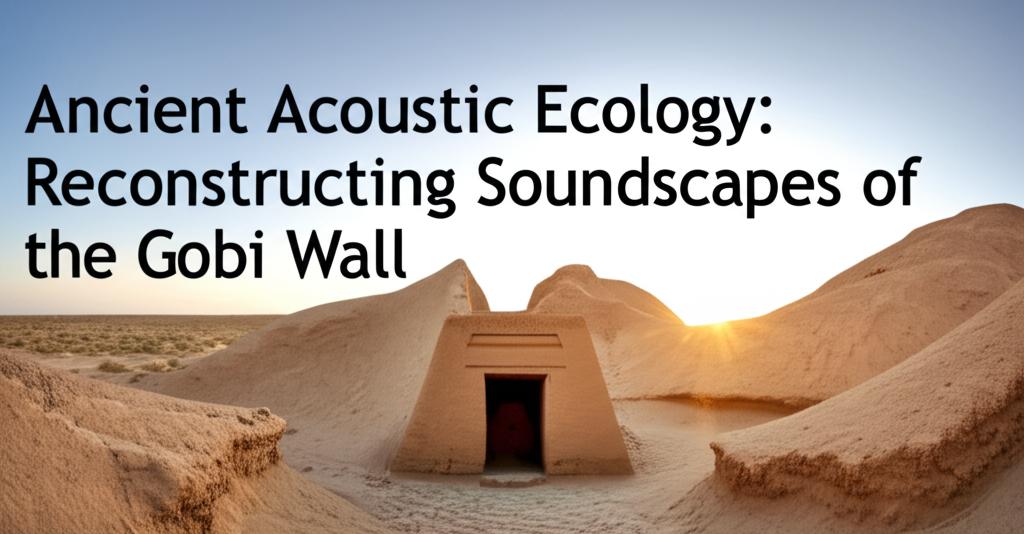Step into the vast, windswept plains of the Gobi Desert, not with your eyes, but with your ears. Imagine the sounds that once defined this colossal landscape, a soundscape now largely silent but for the whispers of the wind across sand and stone. The burgeoning field of ancient acoustic ecology is beginning to piece together this lost auditory world, with a particular focus on monumental structures like the Gobi Wall. This isn't just about hearing the past; it's about understanding how sound shaped human experience, defense, and culture in one of the world's most formidable environments.
Recent archaeological expeditions have shed new light on the Gobi Wall, a sprawling 321 km-long structure of earth, stone, and wood in Mongolia's Gobi highland desert. Traditionally viewed as a purely defensive barrier, cutting-edge research now reveals its multifunctional role during the Xi Xia dynasty (1038–1227 CE). The Gobi Wall system, comprising the main wall, garrison enclosures, and hilltop fortifications, was a sophisticated imperial tool for demarcating territory, managing populations and resources, and consolidating control. Its construction and the strategic placement of its components were intricately linked to the availability of crucial resources like water and wood, and an astute use of geographical features like mountain passes and sand dunes.
But what did this massive undertaking sound like? Archaeoacoustics, the study of sound in historical and archaeological contexts, offers tantalizing possibilities. This interdisciplinary field combines archaeology, acoustics, anthropology, and advanced technologies to investigate how past societies created, utilized, and experienced sound. From the resonance of ancient temples and caves to the sounds of early musical instruments, archaeoacoustics aims to reconstruct the auditory environments of bygone eras.
Reconstructing the soundscape of the Gobi Wall involves several layers of investigation. First, consider the natural soundscape of the Gobi itself – a land of extreme temperatures and vast, open spaces. The wind is a dominant feature, at times a gentle whisper, at others a howling force, capable of making sand dunes "sing" under specific conditions – a phenomenon reported by modern travelers. The sparse vegetation, consisting of small shrubs and grasses, would interact with the wind, creating subtle rustling and hissing sounds. Animal life, though adapted to harsh conditions, would have punctuated the silence with their calls.
Then, layer in the human-generated sounds associated with the Gobi Wall during its active period. The construction itself – the quarrying of stone, the felling and transport of wood, the pounding of rammed earth to create the walls and garrisons – would have produced a cacophony of labor. Within the garrisons, which excavations show had long-term occupation, one can imagine the daily sounds of life: voices in various languages reflecting the diverse population managed by the Xi Xia, the clang of tools and weapons, the movement of people and animals, and perhaps even music or ceremonial sounds.
The strategic purpose of the Wall also implies specific acoustic considerations. Were certain sections of the wall or specific fortifications designed to enhance sound transmission for communication or surveillance? The placement of watchtowers and garrisons, often overlooking mountain passes, suggests a need for effective signaling across distances. While no direct studies on the Gobi Wall's acoustic properties have been published yet, research at other ancient sites, like Chaco Canyon in New Mexico, demonstrates how structures could be designed to allow sounds, such as conch-shell trumpets, to travel across significant distances, binding communities together. Similarly, studies of other ancient walls and megalithic structures reveal that they can possess unique acoustic properties, sometimes amplifying specific frequencies or creating unusual sound effects. Could the Gobi Wall have had sections that functioned as "whispering walls" or created other acoustical phenomena, by design or by chance?
The materials used – primarily rammed earth, with stone and wood reinforcements – would have their own acoustic signatures, affecting how sound reflected, absorbed, or traveled along the structure. The vast, open terrain of the Gobi would influence sound propagation, potentially allowing sounds to carry far, or be deceptively muffled by atmospheric conditions.
Modern techniques in archaeoacoustics, such as digital modeling and auralization, offer pathways to explore these questions. By creating virtual reconstructions of the Gobi Wall and its surrounding landscape, researchers can simulate how different sounds – from human speech and marching feet to the thud of construction and the call of a horn – might have behaved. This allows for an immersive experience of what these ancient sites might have sounded like, providing a deeper understanding of their function and the sensory world of their inhabitants.
While research into the specific acoustic ecology of the Gobi Wall is still in its nascent stages, the existing archaeological understanding of the Wall's construction, purpose, and environment, combined with the methodologies of archaeoacoustics, opens up a fascinating new frontier. Uncovering the ancient soundscapes of this monumental structure promises to add a vibrant, audible dimension to our understanding of imperial power, human adaptation, and life on the medieval frontiers of the Gobi Desert. The whispers of the past are waiting to be heard, offering a richer, more resonant story of this incredible feat of ancient engineering.

